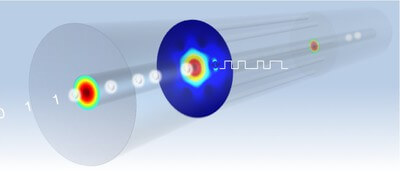Researchers at Bel-Nokia Laboratories succeeded in achieving unprecedented transmission volume and spectral efficiency in a field experiment of optical communications using a new modulation method

[Translation by Dr. Nachmani Moshe]
A joint team of researchers from the corporations Nokia Bell and Deutsche Telekom and from the University of Munich in Germany managed to achieve unprecedented transmission volume and spectral efficiency within a field experiment of optical communication using a new modulation method. The groundbreaking research will be able to expand the ability of optical networks to meet the huge demands for data traffic.
The researchers demonstrated that the flexibility and performance of optical networks can be maximized when the transfer rates undergo dynamic adjustment depending on the channel conditions and the level of traffic demands. As part of the Safe and Secure European Routing project, the researchers, who deployed a network of optical fibers, managed to achieve a transfer rate of one terabyte (TB) per second. This value is close to the theoretically calculated maximum information transfer rate according to the discovery of the researcher Claude Shannon back in 1948. The experiment of the new modulation approach, known as Probabilistic Constellation Shaping (PCS) uses quadrature amplitude modulation (QAM) in order to achieve a high transmission capacity more in a given channel in order to significantly improve the spectral efficiency of optical communication.
The method changes the likelihood of using the system points - the basis for transferring information. Normally, all system points are used equally often. The new modulation method intelligently utilizes high-amplitude system points that are used less frequently than lower-amplitude ones to transmit signals, thanks to the fact that these points, on average, are less sensitive to noise and other defects. With this method, the transfer rate can be changed as desired so that it optimally matches the transfer channel, while providing a rate that is about thirty percent higher than the original rate.
Optical fibers were revealed to the general public fifty years ago. With the promise of fifth-generation wireless technology in the near future, the existing systems for transmitting optical signals continue to evolve and help operators and telecommunications entrepreneurs meet the needs of data traffic while increasing traffic volume at a rate of 100% every year. The new method is now part of this development that allows the flexibility and performance of optical fibers to be increased so that they are able to transmit data at a higher speed and over greater distances without increasing the complexity of the optical network.
The president of Bell Nokia Laboratories, Marcus Weldon, explains: "Future optical networks must not only support high transfer volumes by entire orders of magnitude, but also dynamically adapt to channel conditions and changing demands. Our method offers many benefits to service providers and entrepreneurs by allowing optical networks to operate at a rate close to the theoretical maximum rate required in the digital age of today and the near future."

4 תגובות
So sounds like it's going to be a big problem. Greater than Moore's Law.
Why is there a physical limit to the amount of information? If I understood correctly, several wavelengths can be transmitted on the same fiber.
to an anonymous user
The answer to your question is: no
I am the anonymous user
And in short I wanted to ask if there is even a theoretical technology that transmits more information than an optical fiber. Or more precisely from the theoretical limit of an optical fiber.
Is there any thinking about what will be done when we need to transmit more information than the theoretical limit of the optical fibers? It doesn't sound like a shot per second is a size that will last forever. Especially if you look at the growth in recent years. I suppose it is possible to use several fibers together but the problem is that the growth rate can reach a thousand and even a hundred thousand times in two decades. And it will no longer be easy to double the fiber in such an amount.
In short, does anyone know a technology that can exceed the maximum fiber speed?